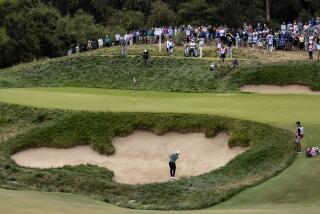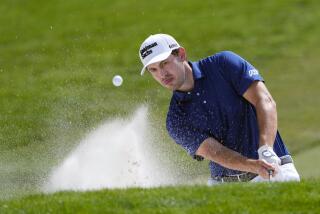Qualifiers Explode Under Real Pressure
They call it a trunk slammer on the PGA Tour.
It’s when a player finishes his second round, throws his clubs in the trunk of his car and leaves the course as fast as he can.
There’s no reason for him to stick around to see if he has made the cut--his scorecard gives him the obvious answer.
Danny Carroll had one of those days at the Nissan Open on Friday at Valencia Country Club. He shot 22-over-par 93, the highest round on the PGA Tour this season, for a two-day total of 168.
Brad Sherfy (77-76--153) had a trunk slammer too. So did Roger Gunn (77-77--154), Jeff Sanday (74-74--148), and Derek Gilchrist (76-79--155).
What these players have in common, besides not making the cut, is that they were all qualifiers.
But it’s not that they can’t play. Quite the contrary.
Carroll shot 66 in his qualifying round, Sanday 65 and Gilchrist 68.
But playing inside the ropes, against the best players in the world and in front of larger galleries than they are used to is a little different.
“It’s tougher playing as a qualifier,” said Sanday, who qualified two weeks ago at the Buick Invitational and finished tied for 16th. “You aren’t used to playing events like this. You put a lot of pressure on yourself because it’s a totally different kind of event.”
Gunn, a teaching pro at Lindero Country Club in Agoura Hills who has qualified for five PGA Tour events and made the cut once, said it’s a mystery to him why qualifiers don’t seem to play well.
“You’re out there trying to visualize the shots and then execute them,” he said. “It’s actually quite similar to playing any other round.”
But Gunn, after a quick glance at his scorecard, added that he is glad to have another way to pay the bills.
There are things besides the pressure of a world-class sporting event that can come into play when you are a qualifier.
Usually you get placed in a low-priority group--those with no big-name players. Tee times are often very early or very late, bringing elements such as cold weather and darkness into play.
And then there’s what happened to Sanday on Friday.
“They started timing us on our shots,” Sanday said. “This is the first time that’s happened to me.”
PGA Tour rules state that players get one warning for slow play then are timed. When it’s their turn to play, they have 45 seconds to hit their shots. If they exceed that time, they are fined $1,000.
Sanday was three over through 15 holes at the time of the warning, but finished double bogey, par, bogey. The cut was at four over.
“The warning got my attention,” he said.
More to Read
Go beyond the scoreboard
Get the latest on L.A.'s teams in the daily Sports Report newsletter.
You may occasionally receive promotional content from the Los Angeles Times.










